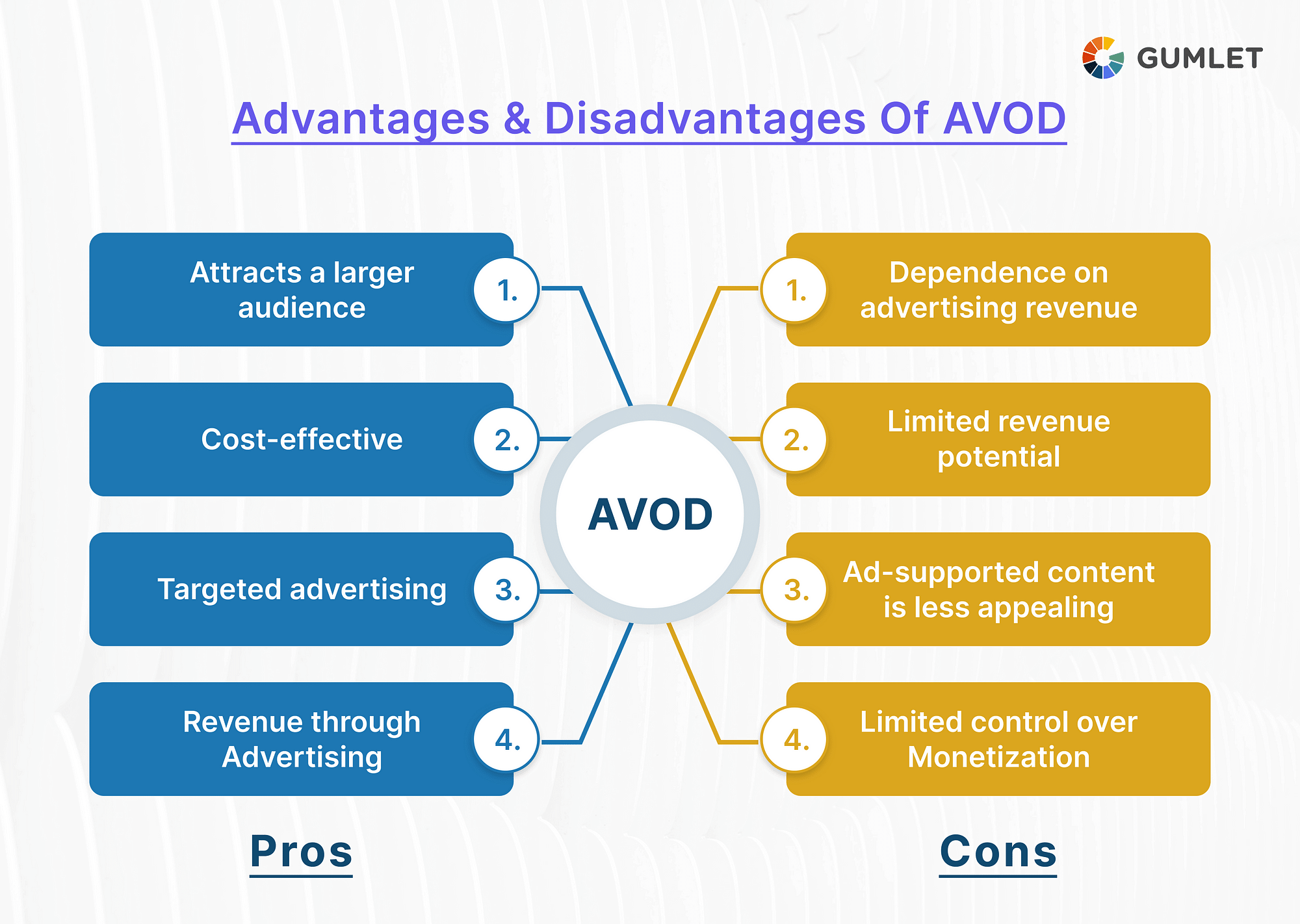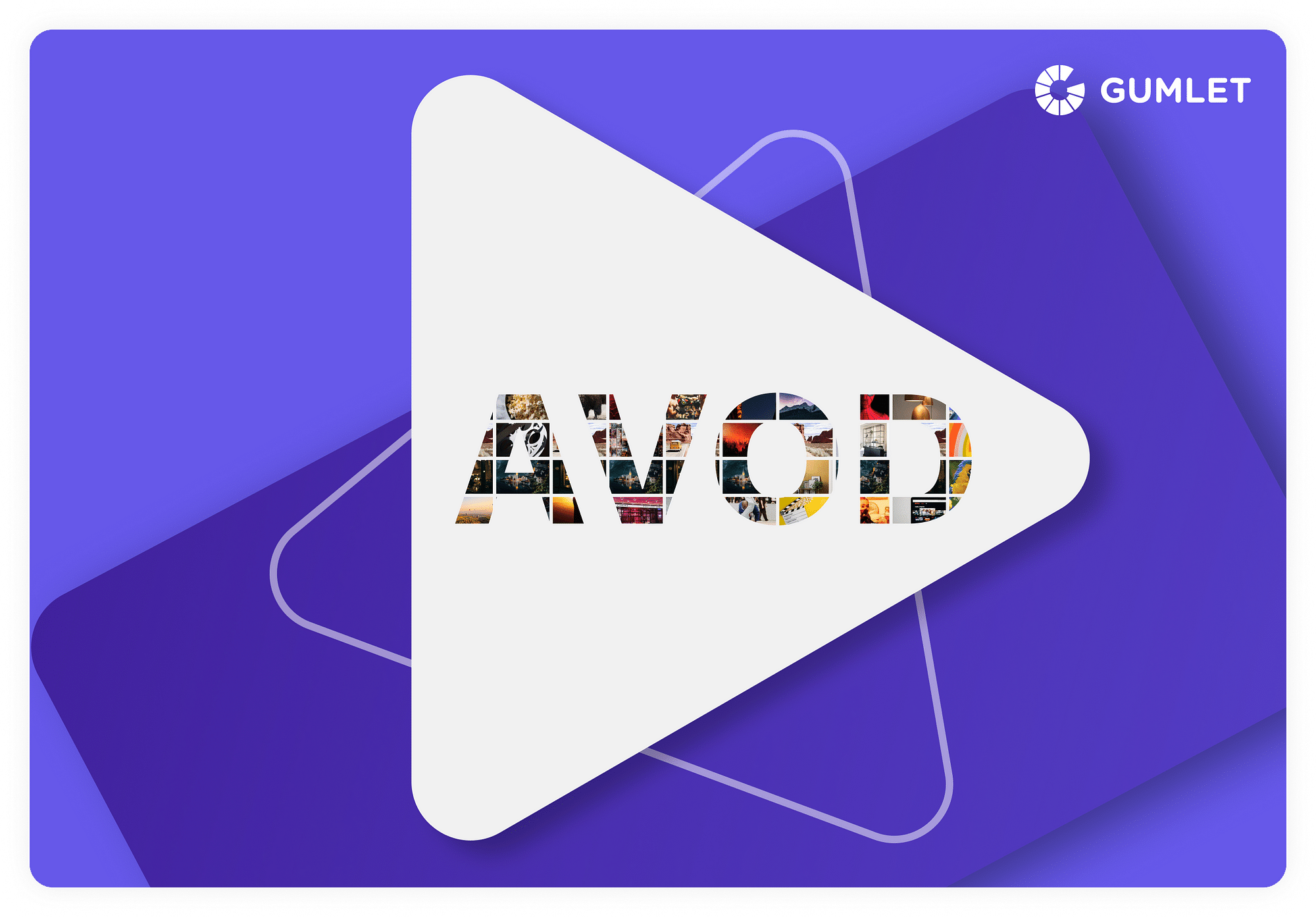With the rise of connected television, AVOD services are quickly becoming a viable alternative to traditional pay-TV services. The constant growth of the streaming market has also fuelled AVOD services to become increasingly popular among consumers. So, What is AVOD? Why is it a popular choice among streaming businesses and consumers? Let's dive in to learn more about this revolutionary way of consuming content!
What is AVOD?
AVOD, or Advertising-based Video On Demand, is a video streaming model in which the content is offered for free to the viewer, with revenue generated through advertising. Users can access the content without paying a subscription fee, but they must watch ads before, during, or after the video. AVOD is a popular video monetization model for streaming platforms, allowing a wider audience to access the content while still generating revenue through advertising.
Examples of AVOD platforms
Some popular AVOD platforms include YouTube, Tubi, and Pluto TV. These platforms have a wide range of content, from movies and TV shows to live sports and educational content.
How is AVOD different from other Monetization Models?
The below table shows how AVOD is different from other on-demand models, such as subscription-based video-on-demand (SVOD) and transactional video-on-demand (TVOD). The main differences between these models are as follows:
AVOD vs SVOD vs TVOD
| AVOD | SVOD | TVOD |
|---|---|---|
| Content is free for the viewer, with revenue generated through advertising | Users pay a monthly or annual fee to access a library of content | Users can purchase or rent individual videos |
| Access to a wider audience as no subscription fee is required | Limited audience as only those who pay the subscription fee can access the content | Limited audience as only those who purchase the video can access it |
| Advertisements are shown before, during or after the video | No advertisements as users have paid for the content | No advertisements as users have paid for the video |
Advantages of the AVOD Model
Some of the key advantages of the AVOD model include:
- Targeted advertising: Advertisers can reach a larger audience and target specific demographics, while viewers can see ads relevant to their interests.
- Cost-effective: AVOD platforms do not have to pay for the content, reducing the cost of the platform and making it more profitable.
- Attracts a larger audience: The lack of a subscription fee makes the platform more accessible to a wider range of people, which can help to increase its popularity.
- Supports free content: AVOD can provide free access to a wide range of content, which can be particularly beneficial for people unable or unwilling to pay for a subscription.
- Offers flexibility: With AVOD, content creators can choose how they want to monetize their content, either through advertising or other methods such as sponsorships or merchandise sales.
- Generates revenue through advertising: By providing targeted advertising to a large and engaged audience, AVOD can generate significant revenue for the streaming platform.
Drawbacks to the AVOD Model
Some drawbacks of AVOD to keep in mind are:
- Dependence on advertising revenue: AVOD relies heavily on advertising revenue, which can be unpredictable and subject to changes in the market.
- Limited revenue potential: Advertising revenue may be lower than other monetization models, such as SVOD.
- Ad-supported content may be less appealing: For some viewers, the presence of advertising can be seen as a negative, reducing the overall appeal of the content.
- Limited control over Monetization: As the platform typically chooses the advertisements, content creators might have limited control over their content monetization.

How Does AVOD Work?
AVOD is a business model where advertisers pay to have their ads shown before, during, or after video content. This allows content creators to monetize their content without charging viewers for access. AVOD is a popular business model for streaming services, websites, and mobile apps that offer video content. In terms of working, there are broadly two types of ad insertion in AVOD: client-side and server-side.
Client-Side Ad Insertion
Through client-side ad insertion, ads can be inserted directly into the video stream on the viewer's device. This is typically done by a software program, known as a client-side player, running on the viewer's device. This method is commonly used for live streaming services, allowing real-time ad insertion.
Advertisers can target specific demographics or geographic regions and update their ads in real time, thanks to the high degree of flexibility and control offered by client-side ad insertion. Additionally, dynamic ad insertion allows different ads to be inserted based on the viewer's location, device, and other factors.
However, client-side ad insertion has its downsides. A stable internet connection is required; latency issues can lead to buffering and a poor viewing experience. Additionally, it can be more complex and resource-intensive compared to server-side ad insertion.
Server-Side Ad Insertion
Server-side ad insertion is a method of delivering ads to a viewer's device by inserting them into the video stream on the server side. The ads are then sent to the viewer's device as part of the video stream. This method is often used for on-demand video content, as the ads do not need to be inserted in real-time.
Server-side ad insertion is relatively simple and less resource-intensive than client-side ad insertion. Furthermore, it can be more reliable and less affected by latency and buffering. Targeting and personalization features such as geographic targeting and dynamic ad insertion can also be used.
However, server-side ad insertion has its downsides too. It can be less flexible and provides less control over ad delivery than client-side ad insertion. Additionally, it requires a higher level of infrastructure and resources, such as a server-side player, a content delivery network, and ad-stitching capabilities.
AVOD Streaming in Different Industries
AVOD streaming has been adopted across various industries to monetize video content. In the entertainment industry, streaming services such as Hulu and Tubi rely on AVOD to provide access to a wide range of TV shows and movies without needing a subscription. Similarly, in the news industry, news networks such as CNN and NBC News use AVOD to monetize their online video content.
Here are some major industries that are heavily utilizing the AVOD model for their benefit:
OTT
Over-the-top (OTT) streaming platforms, such as YouTube and Tubi, have seen significant growth in recent years thanks to the rise of AVOD. With no subscription fee, these platforms can attract a wider audience while generating revenue through advertising. As a result, they can offer a wide range of content, from movies and TV shows to live sports and educational content. This has made OTT platforms more popular among viewers, as they can access a wide range of content at no cost.
Edtech
AVOD is also becoming increasingly popular in the education industry, allowing students to access educational content for free while still generating revenue through advertising. This model is popular among educational institutions and educators as it allows them to reach a wider audience without incurring costs. Additionally, AVOD allows for targeted advertising, which can benefit both the advertiser and the viewer.
Gaming
AVOD has also been adopted by the gaming industry, with game streaming platforms such as Twitch using AVOD to monetize their live streams by displaying ads during the streaming sessions. This allows content creators to generate revenue without charging viewers for access to the content.
Sports
AVOD has become popular in the Sports industry, where sports teams and leagues have started to create their own OTT platforms to distribute their content directly to fans. This includes live streaming of games and events and behind-the-scenes content. The users are then exposed to advertisements during the streaming, thus generating revenue for the teams and leagues.
Conclusion
In conclusion, AVOD is a popular and successful VOD model. The growth of ad-supported streaming and the increasing use of personalized and non-intrusive ad formats will continue to fuel the success of AVOD.
As more and more people turn to streaming platforms for entertainment and education, AVOD will continue to be a popular choice for both content creators and viewers alike. As the streaming industry continues to grow, AVOD will likely become an even more popular choice for both streaming businesses and viewers alike.
FAQs
1. Is YouTube considered Avod?
Yes, YouTube is considered an AVOD platform, as users can access the content for free while revenue is generated through advertising.
2. How is AVOD revenue calculated?
AVOD revenue is calculated by multiplying the number of ad impressions by the ad rate.
3. What type of VOD is Netflix?
Netflix is a subscription-based video-on-demand (SVOD) platform, as users pay a monthly or annual fee to access a content library.
4. What are the top AVOD services?
Some of the top AVOD services include YouTube, Tubi, Pluto TV, and Vudu.
5. AVOD vs. FAST: What is the difference between them?
AVOD and FAST (Free Ad-Supported Streaming Television) are similar because they both rely on advertising to generate revenue. However, FAST typically refers to the ad-supported streaming of live television, while AVOD is more commonly used to stream on-demand content.




